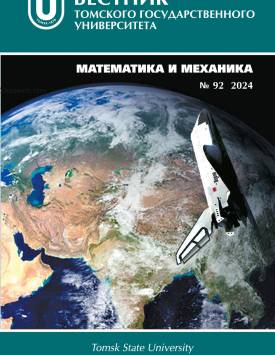Merging of liquid droplets during agglomeration on a combustion surface
When burning high-energy mixed compositions, conditions may arise under which the particles included in the conglomerate melt. In this case, the contacting molten particles merge under the action of surface tension forces and form an agglomerate. The paper proposes a technique for modeling the merging of liquid droplets during the process of agglomeration on the combustion surface. The technique is based on the use of the smoothed particle method (SPH). Problem similarity criteria are presented. Numerical modeling of the processes of merging 2, 3, and 2000 spherical drops was carried out. Mass distribution functions have been obtained. It is shown that the process of agglomeration of large structures consists of two stages. At the first stage, the merging of liquid drops occurs, which at the initial moment of time have points of contact with other drops. At the second stage, an important role is played by nonstationary processes that describe the dynamics of changes in the free surface, which in the general case depend on surface tension, viscosity, and density of the liquid.
Keywords
mathematical modeling,
combustion products,
boron particles,
conglomerates,
agglomerationAuthors
| Rashkovskiy Sergei A. | Ishlinsky Institute for Problems in Mechanics RAS; Tomsk State University | rash@ipmnet.ru |
| Kostyushin Kirill V. | Tomsk State University | kostushink@niipmm.tsu.ru |
| Zhiltsov Konstantin N. | Tomsk State University | konstantin@niipmm.tsu.ru |
| Eremin Ivan V. | Tomsk State University | iveremin@niipmm.tsu.ru |
Всего: 4
References
Bazesefidpar K., Brandt L., Tammisola O. Numerical simulation of the coalescence-induced polymeric droplet jumping on superhydrophobic surfaces // Journal of Non-Newtonian Fluid Mechanics. 2022. V. 307. Art. 104872.
Becker M., Teschner M.Weakly compressible SPH for free surface flows // ACM SIGGRAPH/Eurographics Symposium on Computer Animation. 2007. P. 1-8, 18, 25, 26, 37.
PreonLab 4.2.4. Manual // FIFTY2 Technology GmbH. August, 2020. 179 р.
Peer A., Ihmsen M., Cornelis J., Teschner M. An Implicit Viscosity Formulation for SPH Fluids // ACM Transactions on Graphics. 2015. V. 34 (4). P. 1-10.
Monaghan J., Thompson M., Hourigan K. Simulation of free surface flows with SPH // J. of Comput. Phys. 1994. V. 110. P. 399-406.
Solenthaler B., Pajarola R. Predictive-corrective incompressible SPH // ACM Transactions on Graphics. 2009. V. 28 (3). P. 1-6.
Koschier D. et al. Smoothed particle hydrodynamics techniques for the physics based simulation of fluids and solids // Eurographics. Tutorial, 2019. 41 p.
Рашковский С.А. Структура гетерогенных конденсированных смесей // Физика горения и взрыва. 1999. Т. 35, № 5. C. 65-74.
Jackson T.L., Buckmaster J. Heterogeneous propellant combustion // AIAA Journal. 2002. V. 40 (6). P. 1122-1130.
Rashkovskiy S.A. Direct numerical simulation of nano and conventional aluminum agglomeration in composite solid propellant combustion // International Journal of Energetic Materials and Chemical Propulsion. 2009. V. 8 (1). P. 1-17. 10.1615/IntJEnergeticMaterialsChem Prop.v8.i1.10.
Rashkovskiy S.A. Direct Numerical Simulation of Boron Particle Agglomeration in Combustion of Boron-Containing Solid Propellants // Combustion Science and Technology. 2017. V. 189 (8). P. 1277-1293.
Рашковский С.А. Статистическое моделирование агломерации алюминия при горении гетерогенных конденсированных смесей // Физика горения и взрыва. 2005. Т. 41, № 2. С. 62-74.
Глотов О.Г., Сорокин И.В., Черемисин А.А. Карманная модель агломерации алюминия с тетраэдрической ячейкой для смесевых топлив // Физика горения и взрыва. 2023. Т. 59, № 6. С. 91-97.
Maggi F., DeLuca L.T., Bandera A. Pocket model for aluminum agglomeration based on propellant microstructure // AIAA Journal. 2015. V. 53 (11). P. 3395-3403.
Gallier S., Yiao M. Aluminum agglomeration model calibration with improved experimental data // Journal of Propulsion and Power. 2013. V. 29 (5). P. 1252-1255.
Cohen N.S. A Pocket model for aluminum agglomeration in composite propellants // AIAA Journal. 1983. V. 21 (5). P. 720-725.
Григорьев В.Г., Зарко В.Е., Куценогий К.П. Модель агломерации алюминия при горении смесевых композиций // Физика горения и взрыва. 1981. Т. 17, № 4. С. 9-17.
Maggi F., Bandera A., De Luca L.T., Thoorens V., Trubert J.F., Jackson T.L. Agglomeration in solid rocket propellants: novel experimental and modeling methods // Progress in propulsion Physics. 2011. № 2. P. 81-98.
DeLuca L., Marchesi E., Spreafico M., Reina A., Maggi F., Rossettini L.,.. & Kosowski B.M. Aggregation versus agglomeration in metallized solid rocket propellants // International Journal of Energetic Materials and Chemical Propulsion. 2010. V. 9 (1). P. 91-105.
Бабук В.А. Свойства поверхностного слоя и закономерности горения металлизирован ных твердых топлив // Физика горения и взрыва. 2009. Т. 45, № 4. С. 156-165.
Глотов О.Г. Конденсированные продукты горения алюминизированных топлив. IV. Вли яние природы нитраминов на агломерацию и эффективность горения алюминия // Физика горения и взрыва. 2006. Т. 42, № 4. С. 78-92.
Babuk V.A., Vasilyev V.A., Malakhov M.S. Condensed combustion products at the burning surface of aluminized solid propellant // Journal of Propulsion and Power. 1999. V. 15 (6). P. 783-793.
Глотов О.Г., Зырянов В.Я. Конденсированные продукты горения алюминизированных топлив. I. Методика исследования эволюции частиц дисперсной фазы // Физика горения и взрыва. 1995. Т. 31, № 1. С. 74-80.
Григорьев В.Г., Зарко В.Е., Куценогий К.П. Экспериментальное исследование агломерации частиц алюминия при горении конденсированных систем // Физика горения и взрыва. 1981. Т. 17, № 3. С.3-10.

